Genetic deletion of mGlu2 metabotropic glutamate receptors improves the short-term outcome of cerebral transient focal ischemia
- PMID: 28821279
- PMCID: PMC5562974
- DOI: 10.1186/s13041-017-0319-6
Genetic deletion of mGlu2 metabotropic glutamate receptors improves the short-term outcome of cerebral transient focal ischemia
Abstract
We have recently shown that pharmacological blockade of mGlu2 metabotropic glutamate receptors protects vulnerable neurons in the 4-vessel occlusion model of transient global ischemia, whereas receptor activation amplifies neuronal death. This raised the possibility that endogenous activation of mGlu2 receptors contributes to the pathophysiology of ischemic neuronal damage. Here, we examined this possibility using two models of transient focal ischemia: (i) the monofilament model of middle cerebral artery occlusion (MCAO) in mice, and (ii) the model based on intracerebral infusion of endothelin-1 (Et-1) in rats. Following transient MCAO, mGlu2 receptor knockout mice showed a significant reduction in infarct volume and an improved short-term behavioural outcome, as assessed by a neurological disability scale and the "grip test". Following Et-1 infusion, Grm2 gene mutated Hannover Wistar rats lacking mGlu2 receptors did not show changes in the overall infarct volume as compared to their wild-type counterparts, although they showed a reduced infarct area in the agranular insular cortex. Interestingly, however, mGlu2 receptor-deficient rats performed better than wild-type rats in the adhesive tape test, in which these rats did not show the laterality preference typically observed after focal ischemia. These findings support the hypothesis that activation of mGlu2 receptors is detrimental in the post-ischemic phase, and support the use of mGlu2 receptor antagonists in the experimental treatment of brain ischemia.
Keywords: Focal ischemia; Genetic deletion; Neurological score; Neuroprotection; mGlu2 receptor.
Conflict of interest statement
Ethics approval and consent to participate
Studies involving animals were performed in agreement with the National and International guidelines and regulations on animal care and use, and were approved by the Neuromed Institutional Animal Care and Use Committee. All efforts were made to minimize animal suffering and to reduce the number of animals used.
Consent for publication
Not applicable.
Competing interests
The author(s) declared no potential conflicts of interest with respect to the research, authorship, and/or publication of this article.
Publisher’s Note
Springer Nature remains neutral with regard to jurisdictional claims in published maps and institutional affiliations.
Figures
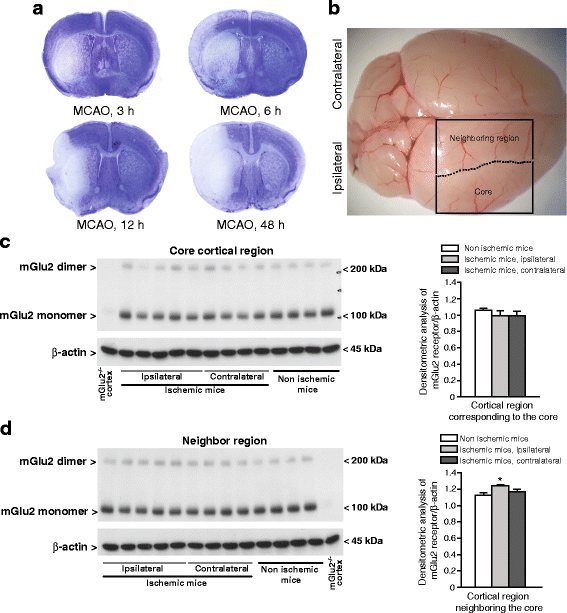

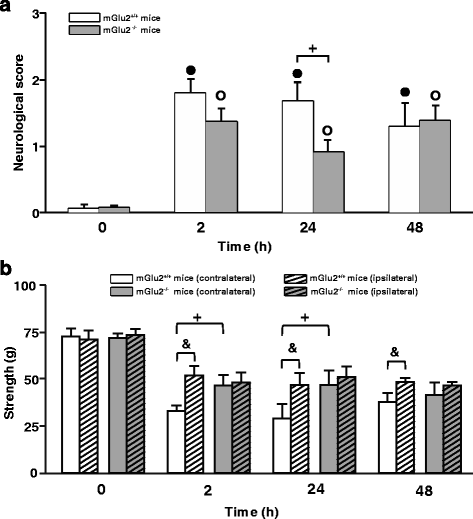
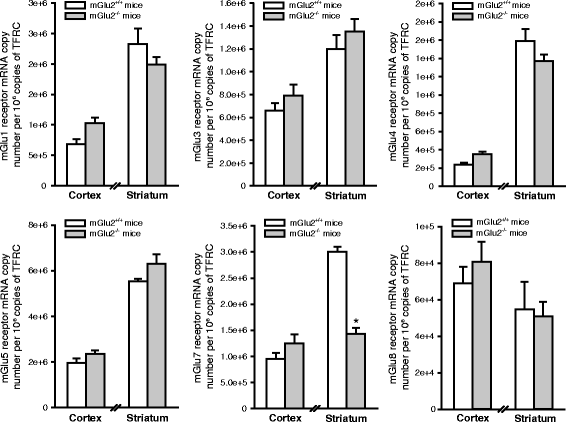
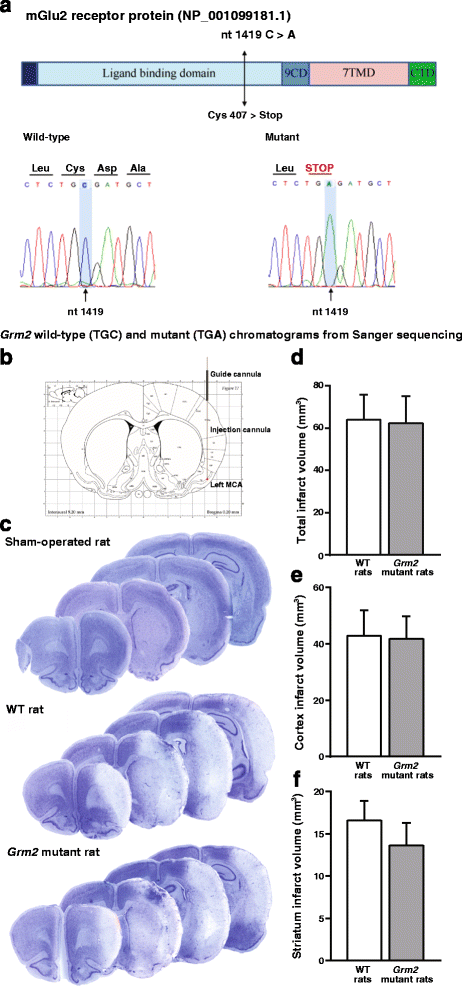
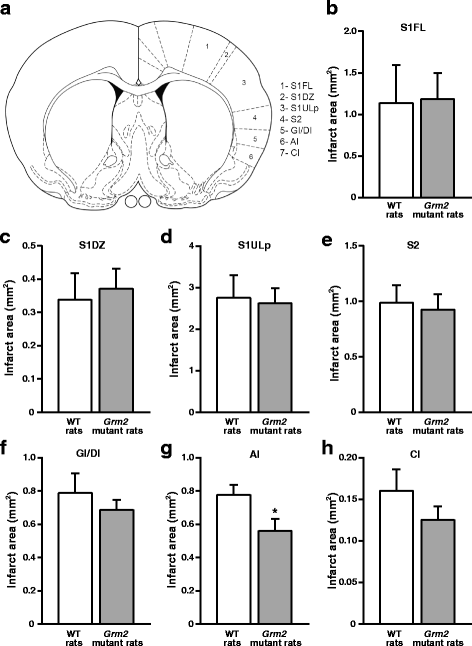
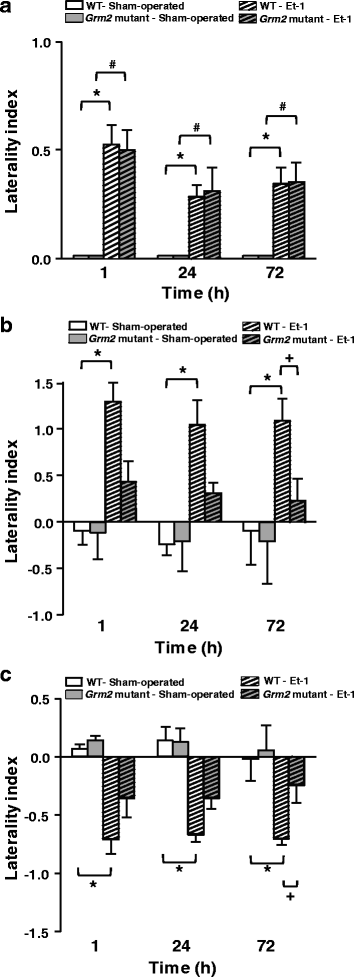
Similar articles
-
Protective role for type 4 metabotropic glutamate receptors against ischemic brain damage.J Cereb Blood Flow Metab. 2011 Apr;31(4):1107-18. doi: 10.1038/jcbfm.2010.201. Epub 2010 Dec 15. J Cereb Blood Flow Metab. 2011. PMID: 21157475 Free PMC article.
-
Targeting type-2 metabotropic glutamate receptors to protect vulnerable hippocampal neurons against ischemic damage.Mol Brain. 2015 Oct 24;8(1):66. doi: 10.1186/s13041-015-0158-2. Mol Brain. 2015. PMID: 26496940 Free PMC article.
-
Behavioral deficits and recovery following transient focal cerebral ischemia in rats: glutamatergic and GABAergic receptor densities.Behav Brain Res. 2003 Jan 22;138(2):187-200. doi: 10.1016/s0166-4328(02)00241-3. Behav Brain Res. 2003. PMID: 12527449
-
Prevalence and influence of cys407* Grm2 mutation in Hannover-derived Wistar rats: mGlu2 receptor loss links to alcohol intake, risk taking and emotional behaviour.Neuropharmacology. 2017 Mar 15;115:128-138. doi: 10.1016/j.neuropharm.2016.03.020. Epub 2016 Mar 14. Neuropharmacology. 2017. PMID: 26987983 Review.
-
Experimental models in focal cerebral ischemia: are we there yet?Acta Neurochir Suppl. 2002;83:55-9. doi: 10.1007/978-3-7091-6743-4_10. Acta Neurochir Suppl. 2002. PMID: 12442622 Review.
Cited by
-
G-Protein-Coupled Receptors and Ischemic Stroke: a Focus on Molecular Function and Therapeutic Potential.Mol Neurobiol. 2021 Sep;58(9):4588-4614. doi: 10.1007/s12035-021-02435-5. Epub 2021 Jun 12. Mol Neurobiol. 2021. PMID: 34120294 Review.
-
Excitotoxic inactivation of constitutive oxidative stress detoxification pathway in neurons can be rescued by PKD1.Nat Commun. 2017 Dec 22;8(1):2275. doi: 10.1038/s41467-017-02322-5. Nat Commun. 2017. PMID: 29273751 Free PMC article.
-
Bilateral transcranial direct-current stimulation promotes migration of subventricular zone-derived neuroblasts toward ischemic brain.FASEB Bioadv. 2023 May 15;5(7):277-286. doi: 10.1096/fba.2023-00017. eCollection 2023 Jul. FASEB Bioadv. 2023. PMID: 37415929 Free PMC article.
-
Exploring the Neuroprotective Effects of Lithium in Ischemic Stroke: A literature review.Int J Med Sci. 2024 Jan 1;21(2):284-298. doi: 10.7150/ijms.88195. eCollection 2024. Int J Med Sci. 2024. PMID: 38169754 Free PMC article. Review.
-
Phased Treatment Strategies for Cerebral Ischemia Based on Glutamate Receptors.Front Cell Neurosci. 2019 Apr 26;13:168. doi: 10.3389/fncel.2019.00168. eCollection 2019. Front Cell Neurosci. 2019. PMID: 31105534 Free PMC article. Review.
References
-
- Corti C, Battaglia G, Molinaro G, Riozzi B, Pittaluga A, Corsi M, et al. The use of knock-out mice unravels distinct roles for mGlu2 and mGlu3 metabotropic glutamate recptors in mechanisms of neurodegeneration/neuroprotection. J Neurosci. 2007;27(31):8297–8308. doi: 10.1523/JNEUROSCI.1889-07.2007. - DOI - PMC - PubMed
-
- Caraci F, Molinaro G, Battaglia G, Giuffrida ML, Riozzi B, Traficante A, et al. Targeting group II metabotropic glutamate (mGlu) receptors for the treatment of psychosis associated with Alzheimer’s disease: selective activation of mGlu2 receptors amplifies beta-amyloid toxicity in cultured neurons, whereas dual activation of mGlu2 and mGlu3 receptors is neuroprotective. Mol Pharmacol. 2011;79(3):618–626. doi: 10.1124/mol.110.067488. - DOI - PubMed
MeSH terms
Substances
LinkOut - more resources
Full Text Sources
Other Literature Sources
Medical
Molecular Biology Databases

